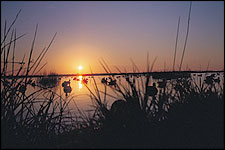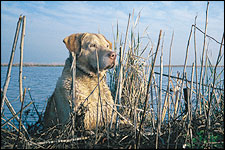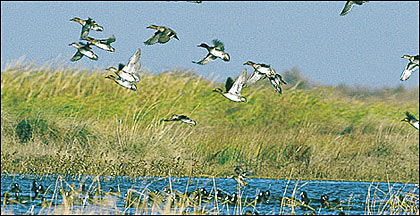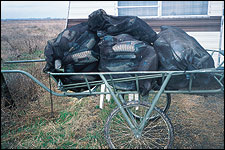November 03, 2010
By Ed Given
By Ed Given
 Central California's large refuges offer quality public hunting opportunities. |
At 6:30 a.m. a hard south wind and driving rain punished my back. As I huddled deeper into my rain gear, I pondered my decision to hunt. I was at Los Banos Wildlife Refuge with my good friend James Delormier. James had called me earlier in the week to say he had the number one draw at Los Banos refuge for Wednesday the 4th and asked if I would like to join him. While I belong to a nearby private duck club, I elected to join James and try the refuge for a change of pace.
Advertisement
Legal shooting time was 6:50 a.m. As it drew near, we both began to doubt James' choice of blinds. A barrage of calling rang out across the marsh, followed by numerous shots, yet we had neither seen nor heard a duck. It's easy to second-guess yourself when you had first choice of blinds and your choice is the quiet one.
Suddenly, a group of ducks appeared to our left in the early morning gloom. A couple of highballs brought the ducks our way, coming in low on James' side. As he rose, shouldering his Remington Model 870 and swinging on the nearest duck, I cried out, "Don't shoot!" I was too late, however, as he crumpled a drake shoveler. The "spoonie" was resplendent in color but not what we had in mind to shoot that early in the day.
Advertisement
As Boomer, my Chessie, delivered the shoveler to James, we spotted a threesome of mallards in front, fighting their way into the wind. It didn't take much coaxing and they found our dekes. Just that quick we had a pair of greenheads down and things were looking up!
From then on we witnessed an almost steady procession of ducks from near and far. As the day brightened, we could identify most of the ducks as mallard and pintail, so we resolved to concentrate our efforts on them.
Often we had teal, wigeon or spoonies landing in our decoys as we called to the larger ducks. Suddenly a pod of pintails--with feet out--were in our face and then quickly flaring into the wind as we jumped to our feet. Two of the handsome drakes stayed with us. When we reached our five-bird limits just before 10 a.m., we shared a cup of coffee and rehashed the morning's events before picking up and bagging our decoys. Besides the chiding that always follows a miss, there had also been some backslapping after several difficult shots. Our final tally was one spoonbill, two pintails and seven mallards.
As we walked back to my pickup, it was still cold and windy, but we stopped for a moment to watch the flocks working the refuge. It had been an inspiring day but not an unusual one in Central California.
That hunt occurred in 1995, and I had hunted the Los Banos refuge only a few times before. I've since had many hunts on Los Banos and other public-access refuges in the grasslands of California, and I believe this region offers waterfowlers one of the best bargains anywhere in the West.
Today, Merced is the second-leading county in the nation for waterfowl bagged each year. Many of those birds are taken on public-access lands.
 The author's Chessie "Boomer" peers over blind at San Luis Refuge. |
HUNTING THE GRASSLANDS
Most of the refuges allow hunting on Saturday, Sunday, Wednesday and holidays, from half an hour before sunrise to sunset. The one exception is Merced Refuge, which only allows shoots on Saturday and Wednesday from half an hour before sunrise to noon. One refuge is for junior hunters only, accompanied by an adult 18 years or older. Some offer assigned blinds only, others are open to roam. Four refuges have blinds reserved for mobility-restricted hunters. One has access only by boat. One has assigned blinds, junior blinds, mobility restricted blinds and a large roam area. Indeed, the Grasslands Refuges offer something for every type of waterfowler. When hunting free-roam areas, a race for chosen cells or ponds sometimes occurs. Astute hunters will already be in their waders when they arrive at their chosen parking areas. Obviously you need not be so rushed when hunting a pre-assigned blind; however, if you are hunting a roam area, be ready before you go through the check line. Then, too, some of the parking lots have vehicle quotas, so preparation is important.
Mentioning quotas brings to mind a hunt at Los Banos in December a few years back. I didn't get to the refuge that Saturday until midday because of holiday duties. When I checked in, my two favorite parking lots were filled, so I opted to try an available blind--one I had not hunted before.
It was one of those crystal-clear, cold days, with a howling northeast wind. I had just settled into my chosen blind, after placing my decoys, when I spied four mallards fighting the wind to the west. It took just a little coaxing from my call and I had them coming my way.
As they parachuted toward my decoys, I found myself looking directly into the sun and could not tell drakes from hens. The limit that year was six birds, but only one could be a hen mallard. With the birds slipping and sliding with the wind, their positions were constantly changing. As I punched the trigger, I had a sickening feeling I had just shot a hen. I was right. By the time I recovered from my mistake, the other three had flared and were gone, along with my hope for a double or triple.
I ended the day with four greenheads and a hen. That was a duck short of a limit--I had passed up a number of shots fearing the dropping of another Suzie. Still it was a great shoot, thanks to my failure at getting either of my two preferences in blinds. You can bet I've since chosen that particular blind a number of times.
DECOYS AND GEAR
While the number of decoys you use and how you arrange them are personal choices, I know one successful hunter who only uses six mallard decoys and pursues mallard exclusively. He tries to only hunt small hidden holes in thick tule patches. You may not want to go to that extreme, but consider weight and bulk when transporting decoys. You generally must travel some distance to get to your area.
 Green-winged teal--the most common species in the area--rocket down a channel of a grasslands refuge. |
Mallard is the decoy of choice at the refuges. Howev
er, unless you plan to shoot mallards only, have a mixture of birds represented in your spread. In my decoy bag I have 20 mallards, four sprigs (all drakes), and six green-winged teal. Sure, I will take straight limits of mallards, but there are many days when that will not happen. So, I increase the odds on those non-mallard days.
Something else to consider is transportation of decoys and other gear to the hunting area. A large number of hunters use mountain bikes and even large three-wheeled bicycles. A variety of carts are used, including large rickshaw types and golf carts. Some hunters simply use backpacks. I use a hand truck with large wheels and tie everything down with bungee cords. It fits in the back of my pickup next to the dog box and is ready to go when the wheels hit the ground.
Some of the blinds do not have seating. Unless you plan on standing all day, you will need some type of seat. I've tried the folding ones made of canvas and aluminum and homemade ones made from plastic and wood. Today, I carry a five-gallon plastic bucket in my decoy bag. My six teal decoys fit in it and the rest of my blocks stack around and on top of it. It's convenient and takes up little room. I drill a couple of holes in the bottom (seat) allowing captured air to escape, so the bucket does not pop to the surface when I stand to shoot.
THE BIRDS
While the green-winged teal is the number one duck in the grasslands, other species can be found in abundance. Most hunters prefer the larger birds but many target greenwings for both sport and table quality.
Historically, this is pintail country, but since their decline and subsequent restrictions, they have become less a factor in bag numbers. They are, however, still a favorite among many hunters. Mallards have now become the most sought after duck on the refuges, and some of the areas are groomed just for them. Almost all the refuges have their hard core followers who have learned the favored ponds or cells, as they are often called, of the mallard and pursue this bird exclusively.
Gadwall, American wigeon, cinnamon teal and shovelers make up the majority of other species of puddle ducks on these refuges, with all providing sport and sometimes day-saving action.
On one recent afternoon hunt I ended up at Kesterson. I had things to do that morning, so when I got to the San Joaquin Valley, I went directly to Los Banos Refuge and got in line for an opening. After waiting 11⁄2 hours at Los Banos, I gave up and drove to Kesterson and got a blind immediately.
When I finally got my decoys out and was settled into the roomy three-man blind, it was almost 2 p.m.
 A cart transports the author's gear on the larger refuges where hunting areas are some distance from parking lots. |
There was a thick overhead fog, with a ceiling of about 200 yards. While putting out my blocks, I had seen occasional groups of ducks and geese drifting in and out of the high fog. As 5:00 p.m. was the shooting deadline, I knew I would be grateful for what might come my way.
When legal shooting time came to an end, I had five ducks. Two drake greenwings, a drake and hen spoonie and a hen ringneck--hardly a glamorous string of birds but day-savers under the circumstances. Who knows, I might have still been waiting at Los Banos!
The grasslands hold good numbers of divers throughout the season. The most prolific is the ringneck, and these speedsters coming in low over a tule patch can be in and gone before you can yell, "Teal?"
In some years, decent populations of canvasbacks and redheads can also be found here, along with a smattering of ruddies and lesser scaup. Huge numbers of snow geese winter on the entire grasslands area, along with smaller numbers of specks and various races of honkers.
Those willing to pay their dues on public areas can learn secrets of the grassland refuges. For the most part, specific hot spots must be found by watching the birds. Hunters who show consistent results are generally quiet about the areas they hunt, as can be expected. But with a little time and effort invested on the grasslands, anyone can enjoy some of the finest waterfowling Central California has to offer.
| Refuges Of The Grasslands | 
 |

CHINA ISLAND WILDLIFE REFUGE
China Island is bordered on the north by the San Joaquin River, while Mud Slough meanders through a good part of it. It is interspersed with flooded checks and dry uplands. There are planted checks--some flooded and some left dry for pheasant. FREITAS NATIONAL WILDLIFE REFUGE
The Freitas Unit, as it is known, provides boat-only access as all hunting is done on Salt Slough. To the west, Freitas is bordered by Highway 140 and to the east Highway 165 splits what's known as the north and south units.
If you plan to hunt on normal shoot days for the refuges (Wednesday, Saturday, Sunday or holidays) you must obtain a boat permit. WEST BEAR CREEK REFUGE
Just south of Freitas and east of Highway 165 is the West Bear Creek Unit. West Bear first opened to hunting in the winter of 1998. Hunters must check in at the Salt Slough check station and choose one of four wetland units. West Bear Creek is roam-only unit with a lot of potential. KESTERSON NATIONAL WILDLIFE REFUGE
Directly south across Highway 140 from China Island lies Kesterson Refuge. Kesterson does not allow roam hunting, but instead has 32 blinds. The blinds are either steel box type or concrete barrel blinds. There is a total of 17 three-person and 15 two-person blinds.. SAN LUIS NATIONAL WILDLIFE REFUGE
Just south of the West Bear Creek, is the San Luis Refuge. San Luis is a free-roam area, although I've been told it has a number of existing blinds available on a first-come first-served basis. San Luis is a large refuge and has varied marsh and upland cover. There are large ponds dotted with tule patches, narrow meandering sloughs and a mixture of both--creating a very ducky marshland. San Luis has a devoted group of mallard hunters, although good numbers of all species of duck and geese can be found there. BLUE GOOSE NATIONAL WILDLIFE REFUGE
South of Kesterson on the west side of Highway 165 from San Luis is the Blue Goose Refuge. Blue Goose is the smallest of the grassland refuges and is modeled after Kesterson, with assigned-blind hunting only--no roaming allowed. Blue Goose has six well-spaced blinds. Blind number one is a two-man blind, the other five blinds are three man. Hunters must check in and out at Salt Slough. SALT SLOUGH WILDLIFE AREA
Adjacent to San Luis Refuge east of Highway 165 is Salt Slough. Established in 1993, it has become a mecca for mallard hunters. It is a long, narrow, fairly open marshland planted with water grass, a favored forage of the mallard.
Salt Slough is a free-roam area, except it has one blind for mobility restricted hunters. LOS BANOS WILDLIFE AREA
South of San Luis and Salt Slough Refuges is Los Banos Wildlife Refuge, the oldest in the grasslands and one of the largest. Los Banos could be called the complete refuge, with two blinds reserved for the mobility-restricted hunter and three blinds set up for the junior hunter (accompanied by an adult). In addition, Los Banos has 18 blinds available on a first-come first-served basis, plus a large free-roam area. The blinds are strategically placed adjacent to the "No Hunt" zone. Los Banos has nine parking lots, with quotas on each. VOLTA WILDLIFE AREA
A short drive west of Los Banos is the Volta Refuge, a 3,000-acre refuge that consistently ranks near the top in number of birds taken per hunter. Volta is a free-roam refuge with no permanent blinds and a large following of devoted waterfowlers. Volta is known for holding large numbers of pintail. The sprigs are still there but hunters have had to change tactics and key in on other species. MUD SLOUGH WILDLIFE REFUGE
Just a short distance south of Los Banos is the 550-acre Mud Slough Refuge. Mud Slough is bordered on the south by Highway 152, affording easy auto access. Mud Slough is unique in that it is a junior hunter refuge only. Junior hunters must be accompanied by adults. Adults accompanying junior hunters can also hunt, although only one adult is allowed per two junior hunters.
There are three concrete blinds, three platform blinds and a metal tank blind. There are also five "stake" blinds where hunters are allowed to hunt within 100 yards of numbered posts. GADWALL WILDLIFE AREA
Gadwall is bordered on the north by Highway 152 and the east by Santa Fe Grade road. This former private duck club sits amidst other clubs and, though it has no other refuges in close proximity, it is in an excellent flyway.
Gadwall is a free-roam area, yet it has numerous blinds on it from the former private club. The blinds are marked on a map that can be obtained from the Los Banos and Salt Slough check stations. Hunters are cautioned to bring a bucket to hunt one of the blinds, as they may need bailing. MERCED NATIONAL WILDLIFE REFUGE
To the east of all the other grassland refuges is Merced. There are many private clubs in the surrounding area known for its abundance of waterfowl.
On Merced, all hunting is done from assigned blinds. One unique feature is that Merced only allows hunting on Saturdays and Wednesdays, and shooting time ends at noon. There are 17 blinds, plus a mobility-impaired blind. Two of the blinds are goose pits, with room for three people in each. MENDOTA WILDLIFE AREA
Mendota Refuge is about an hour's drive south of the town of Los Banos and just northwest of Fresno. Mendota is the largest of the grassland refuges with 12,000 acres under management. Mendota can accommodate more hunters (600-plus) than any other refuge in central California.
Mendota is split by Fresno Slough where hunting from a boat is allowed. In addition it has four mobility-impaired blinds. Otherwise, Mendota is strictly a roam area.
Mendota is renowned for its production of mallards, as well as other duck species, and many hunters from central and southern California drive many miles to hunt it.
Mendota refuge has an area called Tent City, which allows the leaving of unattended trailers and campers for the entire hunting season. For information in this regard, call 559/655-4645. Los Banos and Salt Slough Refuges also allow the leaving of unattended trailers and campers via a limited drawing for space each fall. Contact the Los Banos office for details at 209/826-0463. |
|
|
